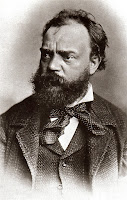 |
| Image from http://upload.wikimedia.org/wikipedia/commons/c/c8/Sean-o-riada.jpg |
Wednesday, 13 May 2015
Seán Ó Riada
Manuel de Falla
 |
| Image from http://upload.wikimedia.org/wikipedia/commons/1/19/ManuelDeFalla.JPG |
Manuel de Falla was born in Cadiz, Spain in 1876. He is regarded as one of Spain's greatest 20th Century composers. He was considered a nationalist and the pieces he composed had a definite Spanish style. He generally only used certain features or parts of original folk songs to give this Spanish style. Falla had a particular interest in native Andalusian music, especially flamenco. This is strongly heard in many of his works. He used the lively flamenco dance rhythms and the aspects of the 'cante hondo' type of song which are found in Andalusian folk music in many of his compositions. In 1902, he studied composition with Pedrell for three years. He taught that folk-song should be the basis of a nation's music. Falla then spent a few years in Paris, from 1907 to 1914. There he met many French composers, including Debussy, Ravel and Dukas, who's orchestrations influenced his style a lot. He then moved back to Madrid and wrote the music for 'El Amor Brujo' - a ballet. It was known for its great use of Andalusian folk music. He then composed many other works that made Falla known as the leading Spanish composer, for example 'Noches en los Jardines de España' (1916) and 'El Correegidor y La Molinera' (1917).
Bela Bartok
 |
| Image from http://upload.wikimedia.org/wikipedia/commons/6/66/Bartók_Béla_1927.jpg |
Bela Bartok was born in 1881 in Nagyszentmiklós, Hungary (now Romania) and was one of the most famous 20th Century composers. He studied in Budapest from 1899-1903 at the Royal Academy of Music. It's said Bela was a nationalist and was very proud of his country and culture. He showed a particular interest in the folk music of his country, Hungary, and also of Slovakia, Romania and Bulgaria. He and Zoltán Kodály, a Hungarian composer whom he collaborated with, dedicated their lives to collecting and finding out more about this folk music. While searching, they realised that Hungarian folk music uses isometric strophe structure, a tempo giusto (strict tempo) and many pentatonic formations. These features are to be found in many of Bartok's pieces. He also tended to use a different type of harmony and tonality in his works to other previous composers which he found in Hungarian folk music and even in the folk music of the countries around him. He didn't use traditional harmony. Examples of pieces where his Hungarian style is shown would be his Fifteen Hungarian Peasant Songs and Hungarian Sketches. In 1940, Bela Bartok moved to New York. It's said he lost creativity when he moved here at first. Although, after a while he composed his Viola Concerto, 3rd Piano Concerto, Concerto for Orchestra and Sonata for Solo Violin. In these works, Bartok kept his definite Hungarian style, despite not living in his home country.
Monday, 11 May 2015
Pyotr Ilyich Tchaikovsky
 |
| Image from http://upload.wikimedia.org/wikipedia/commons/0/02/Tchaikowsky.jpg |
Tchaikovsky studied in the St. Petersburg Conservatory and graduated with a silver medal in 1865. As St. Petersburg is quite close to Europe, it's said a western style of music was taught there. This explains the western style heard in Tchaikovsky's music, which is quite varied from the music of other Russian composers at the time. It's said this is a good thing as he became very popular amongst people in the West. This made his music spread very far. However, his music still had a distinctive Russian style and it's clear he loved the folk music of his country. An example of this would be his 50 Russian Folk Songs for Piano Duet. In his Symphony no. 2 he also used a lot of folk music, this time from his neighbouring country, Ukraine. It was nicknamed the 'Little Russian' as he used three folk songs from Ukraine in the work.
Monday, 27 April 2015
Antonín Dvorak
 |
| Image from http://upload.wikimedia.org/wikipedia/commons/f/fb/Dvorak1.jpg |
Antonin Dvorak was born in Nelahozeves (a Bohemian village near Prague in the Austrian Empire, now Czech) in 1841, where he lived for most of his life. As a composer it was definitely clear he was inspired by Czech traditional music as he often used the form of Slavic folk dances, for example in his Slavonic Dances. Dvorak was a romantic composer. The romantic era was when composers began to show lots of emotion and expression in their works. This was around the same time as revolutions and uprisings were happening across Europe. In the Czech Republic in the 19th Century the ideas of the French revolution and nationalism grew to be very important and in 1848 there was a revolution.
In 1892 Dvorak moved to New York where he became the National Conservatory of Music director. One of his aims of visiting the country was to find out more about American music. In particular, he took a strong interest in African American and American Indian music. While there, he wrote his Symphony no. 9 - "From the New World". He also composed the "American" String Quartet no. 12 in F Major, the String Quintet no. 3 in E flat Major, the Cello Concerto in b minor, Humoresque in G flat major and a Sonatina op.100 in G Major for violin and piano. It's said he took up a definite American style in these works.
Overall, Dvorak is a prime example of a composer who's style was inspired by where he lived.
Friday, 17 April 2015
Intro
Hi there! I'm Anna and I'm going to be writing my blog on a few of my favourite classical music composers and how where they were from and where they lived influenced their compositions. I hope you enjoy reading it!
Subscribe to:
Comments (Atom)